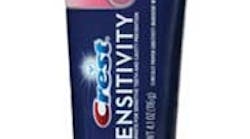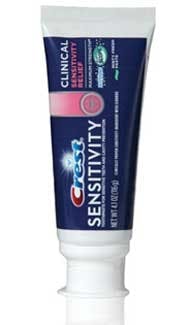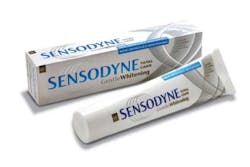Dentin hypersensitivity is a clinical condition that is chronic, with acute episodes of discomfort. Numerous theories have been proposed; the most widely accepted being the hydrodynamic theory.(1) It is necessary to screen for hypersensitivity, educate patients about preventable risk factors, promote long-term management, and follow up on a continual basis. It is also critical to perform a differential diagnosis to rule out pathology, such as an endodontic or restorative problem.
Dentin tubules are filled with fluid and in normal circumstances and when not distressed, this fluid exerts a mild outward flow. Thermal, evaporative, tactile, osmotic or chemical stimuli, when directed into open tubules, cause movement of fluid within the tubes. The feelings of heat and cold cause fluid to move in opposite directions. Heat causes expansion of the dentin tubule, inducing a rather slow inward movement of fluid. This is usually recognized as a major pain causing phenomenon. Cold and evaporative stimuli cause contraction of the tubules resulting in a fast outward flow, and this is often the cause of complaints from patients.The flow of fluid in the dentin tubules of sensitive teeth can be up to 100 times greater than in non-sensitive teeth.(2) The movement alters the nerve fibers at the pulp-dentin border or within the dentin tubule, and is perceived by the individual as an acute pain. In order for this to occur, the dentin must be exposed and the dentin tubule must be patent to the pulp. Dentin may become exposed for a number of reasons, such as enamel loss or gingival recession, or acid erosion.
Treatments can include desensitizing toothpastes, dentifrices, prophy pastes and powders, or mouthrinses with fluoride, potassium nitrate, potassium chloride or potassium citrate. We also now have calcium phosphate, NovaMin, Pro-Argin, diammine silver fluoride, and laser technologies to employ. In-office treatments can include potassium oxalate, ferric oxalate, fluoride varnish, oxalic acid and resin, sealants, primers, and lasers.
New York University (NYU) College of Dentistry researchers identified a new method for treating tooth hypersensitivity, while simultaneously preventing bacteria from causing further harm. In the NYU dental study, a coating made from fluoride and zinc ions in a calcium-phosphate matrix proved effective in reversing damage to the tubules caused by Streptococcus mutans.
The coating not only caused the exposed tubules to close again, but also prevented Streptococcus mutans from causing further damage. The findings were presented on July 17, at the 2010 annual meeting of the International Association for Dental Research in Barcelona, Spain.(6)
The ADA has a program to evaluate “Products for the Treatment of Dentinal Hypersensitivity.” Guidelines from the Council on Scientific Affairs outline the criteria.(7)
This issue will review calcium phosphate technology; potassium nitrate, sodium fluoride, strontium chloride, and NovaMin technologies; Pro-Argin technology; and the use of lasers to relieve hypersensitivity.
For two interesting videos, visit:
www.colgateprofessional.com/professionaleducation/Pro-Argin-Technology-Mode-Of-Action/video and www.dental--health.com/video_demineralized_teeth.html.
References
1. Dababneh RH, Khouri AT, Addy M. Dentine hypersensitivity – an enigma? a review of terminology, epidemiology, mechanisms, aetiology and management. Br Dent J 1999; 187(11):606-11.
2. Addy M. Dentin hypersensitivity: new perspectives on an old problem. pp. 367-375. Proceedings of a symposium held at the FDI World Dental Congress, Vienna 2002. International Dental Journal 2002; 52(5):366-396.
3. Haywood VB. Dentin hypersensitivity: bleaching and restorative considerations for successful management. pp. 376-384. Proceedings of a symposium held at the FDI World Dental Congress, Vienna 2002. International Dental Journal 2002; 52(5): 366-396.
4. Hewlett ER. Etiology and Management of Whitening-induced Tooth Hypersensitivity. CDA Journal, Vol 35, No 7, 499-506, July 2007.
5. Addy M, Hunter ML. Can tooth brushing damage your health? Effects on oral and dental tissues. Int Dent J 2003; 53 (supplement 3):177-86.
6. www.nyu.edu/about/news-publications/news/2010/08/20/nyu-dental-study-identifies-promising-new-approach-for-treating-tooth-hypersensitivity.html.
7. www.ada.org/sections/scienceAndResearch/pdfs/guide_prod_hypersensitive.pdf.
Additional Reading
1. Orchardson R and Gillam DG. Managing dentin hypersensitivity. J Am Dent Assoc 2006; 137; 990-998.
2. Garcia-Godoy F, Panagakos F, Schiff T, et al. Introducing Pro-Argin A Breakthrough Technology Based upon Arginine and Calcium for In-Office Treatment of Dentin Hypersensitivity. American Journal of Dentistry, Vol. 22, Special Issue A, March, 2009 - p. 1A - 24A.
3. Brugnera A, Garrini AE, Pinheiro A, Souza Campos DH, Donamaria E, et al. Laser Therapy In The Treatment Of Dental Hypersensitivity -A Histologic Study And Clinical Application. Laser Therapy Vol. 12, 16-21.
4. Cunha-Cruz , Stout R, Heaton LJ, Wataha JC and for Northwest PRECEDENT. Dentin Hypersensitivity and Oxalates: a Systematic Review. J Dent Res 2011 90: 304 originally published online 29 December 2010.
5. Kasper D. Dentinal hypersensitivity: Assessing a chronic problem. Oct 2009. www.rdhmag.com/index/display/article-display/369655/articles/rdh/volume-29/issue-9/feature/dentinal-hypersensitivity-assessing-a-chronic-problem.html.
6. Kasper D. Hypersensitivity exposed. June 2010. www.dentistryiq.com/index/display/article-display/6859761595/articles/rdh/volume-30/issue-6/features/hypersensitivity-exposed.html.
7. Walters PA. Dentinal Hypersensitivity: A Review. The Journal of Contemporary Dental Practice, Volume 6, No. 2, May 15, 2005.
8. Porto ICCM, Andrade AKM, and Montes MAJR. Diagnosis and treatment of dentinal hypersensitivity. Journal of Oral Science, Vol. 51, No. 3, 323-332, 2009.
9. Castillo JL, Rivera S, Aparicio T, Lazo R, Aw TC, Mancl LL and Milgrom P. The Short-term Effects of Diammine Silver Fluoride on Tooth Sensitivity : a Randomized Controlled Trial. J Dent Res 2011 90: 203 originally published online 30 November 2010.
10. Hewlett ER. Etiology and Management of Whitening-induced Tooth Hypersensitivity. CDA Journal, Vol 35, No 7, 499-506, July 2007.
11. Pashley DH, Tay FR, Haywood VB, Collins MA, Drisko CL. Dentin Hypersensitivity: Consensus-Based Recommendations for the Diagnosis & Management of Dentin Hypersensitivity. October 2008, Volume 4, Number 9 (Special Issue), 1-40.
12. American Dental Association. Professionally applied topical fluoride: Evidence-based clinical recommendations. J Am Dent Assoc 2006;137(8):1151-1159.
13. Schiff T, He T, Sagel L, Baker R. Efficacy and safety of a novel stabilized stannous fluoride and sodium hexametaphosphate dentifrice for dentinal hypersensitivity. J Contemp Dent Pract 2006;7(2):1-8.
14. Haywood VB, Cordero F, Wright K, et al. Brushing with potassium nitrate dentifrice to reduce bleaching sensitivity. J Clin Dent 2005:16(1):17-22.
15. Bartold PM. Dentinal hypersensitivity: a review. Australian Dental Journal 2006;51:(3):212-218.
Sincerely,
To read previous FOCUS introductions by Maria Perno Goldie, RDH, MS, go to introductions.











